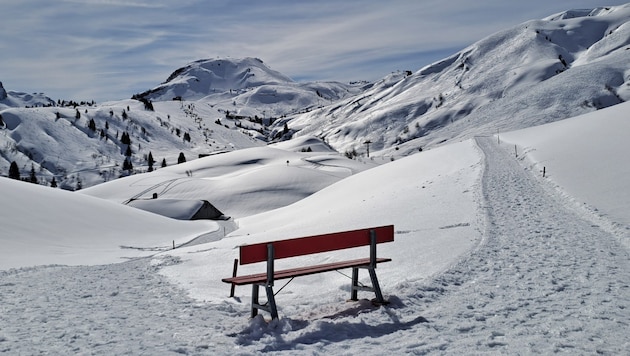Most beautiful hiking routes
Gaisbühel Alpe: a place full of nostalgia
From Tannegg in Oberlech, the high trail leads across a sunny high plateau to the Gaisbühel Alpe. The building is a relic of a bygone era and impresses with its authentic character.
The winter season in the Lech/Zürs ski area lasts until April 21. This is another opportunity to go on a winter hike in spring weather. This time it's along the high-altitude trail to the Gaisbühel Alpe. To do this, you first have to get from Lech to Oberlech - either on foot in just over half an hour or by train, which runs every 15 minutes. Once you arrive in Oberlech, first follow the signposts leading to "Tannegg/Höhenwege". This involves crossing the ski slope once. At Tannegg, the groomed path to the Gaisbühel Alpe is signposted at just under four kilometers. You pass a lift station, soon after which the route becomes a little more secluded and leads in a wide arc over a high plateau. The biggest climb is now behind you and the ascent is moderate.
Tips & information
Type: Winter hike
Duration: approx. two and a half hours from Oberlech
Starting point: Lech town center or Oberlech mountain station
Equipment: sturdy shoes with good tread soles, possibly gaiters, hiking poles, sun protection, drink, layered clothing suitable for the weather
Refreshment stops available in Lech and Oberlech Public transport: Bus route 750 S from Langen am Arlberg train station
Note: the winter season in Lech ends on April 21
Even if the panorama still looks very wintry, the intense sunlight and the associated warming during the day have already led to a loss of firmness in the snow cover. Particularly on steep slopes and in the vicinity of the Kitzibachtobel, clear cracks and break-offs can be seen - a typical situation in spring. You should therefore always stay on the prepared route. In open terrain, it is also difficult to make progress as you sink knee-deep into the snow after just a few steps.
A place with a long history
Soon you have left the foothills of the ski area behind you and can enjoy the magnificent mountain panorama in peace and quiet. The buildings of the Gaisbühel Alpe can just about be made out from afar: as dark patches clinging to the mountainside like swallows' nests. People have been farming up there since the Middle Ages. For example, it is documented that in 1260, the people on the "Gauspuhli" were obliged to supply the Swabian monastery of Weingarten with interest in kind in the form of cheese. The mule track over the Gaisbühel is mentioned in documents dating back to 1422. Originally, the alp was probably inhabited for a large part of the year; the centuries-old log building is a relic of the former Walser settlement.
Mountain cheese was made in the building until 1969. Today it is still a special place, a nostalgic spot where hikers can take a break and enjoy the unique view. Time seems to have stood still at the Gaisbühel Alpe: Wind and weather have stained the wood of the building dark over many years - like an ark, it sticks out of the snow and stands out against the lightning-blue spring sky. Nothing disturbs the peace and quiet and you can listen to the meditative splashing of the meltwater dripping from the gutters. After the relaxing break, we head back towards Oberlech.
Alpine accentor
The alpine accentor is a bird of the high mountains and is found in Central Europe in the Alps, the Carpathians and the Sudetes. Its habitat is mainly sunny rock faces above the tree line. The animals often stay on the ground and hide in crevices when in danger. In winter, the alpine accentor can often be found in the vicinity of ski huts and mountain villages. In summer, the birds feed mainly on insects; in the cold season, seeds are the main food. The birds can also be found at feeding places. The alpine accentor has developed a complicated reproductive system , which to a certain extent compensates for the losses of harsh winters and includes all conceivable combinations and constellations, from monogamy to polygamy.
A few meters after the alp building, you have the option to vary the route a little and either hike over a small hill past a wooden cross or stay on the familiar route. Finally, both paths meet again and you follow the familiar path back to the starting point.
















Kommentare
Liebe Leserin, lieber Leser,
die Kommentarfunktion steht Ihnen ab 6 Uhr wieder wie gewohnt zur Verfügung.
Mit freundlichen Grüßen
das krone.at-Team
User-Beiträge geben nicht notwendigerweise die Meinung des Betreibers/der Redaktion bzw. von Krone Multimedia (KMM) wieder. In diesem Sinne distanziert sich die Redaktion/der Betreiber von den Inhalten in diesem Diskussionsforum. KMM behält sich insbesondere vor, gegen geltendes Recht verstoßende, den guten Sitten oder der Netiquette widersprechende bzw. dem Ansehen von KMM zuwiderlaufende Beiträge zu löschen, diesbezüglichen Schadenersatz gegenüber dem betreffenden User geltend zu machen, die Nutzer-Daten zu Zwecken der Rechtsverfolgung zu verwenden und strafrechtlich relevante Beiträge zur Anzeige zu bringen (siehe auch AGB). Hier können Sie das Community-Team via unserer Melde- und Abhilfestelle kontaktieren.